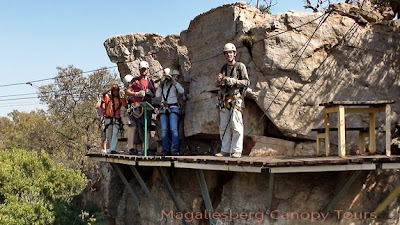At Chobe we bid farewell to four of our
companions who departed on the long road home to Johannesburg.
That left just 6 of us to go on to
Hwange National Park in Zimbabwe. The distance was not far, but the
last 100km to our campsite was dirt road (track in some places) and
we eventually arrived at our camp (with waterhole) just before
sunset.
As we arrived a herd of dusty, gaunt
elephant were jostling for water at the trough just below the hide.
We spent a wondrous half hour watching these giants of the bush, just
a few metres away from us. Then as darkness fell we set up camp and
started cooking our supper on the fire.
Any thoughts of a leisurely nightcap
watching the flames die down were blown away as we were chased into
our tents by a huge thunderstorm. It crashed and flashed most of the
night and we rose to a clear rain washed morning.
I will write another time of the
amazing transformation that the mopani tree country went through over
the next four days of blazing sun, sticky heat and nightly
thunderstorms.
The most immediate impact was that the
elephant vanished into the far reaches of the bush, no longer totally
dependent on our waterhole. But we weren't on this trip to only look
for animals. For the time we were there, we were the only humans at
this waterhole with it's three resident hippo, one crocodile,
visiting birds and occasional larger animals.
The word “peace” is really totally
inadequate to describe our stay in Hwange.
 |
| Exploring Hwange |
 |
| Sundowners at our own private waterhole |
Packing up our camp on the fifth day,
we all vowed that we would return, some day......
Then it was back to Botswana (over that
100km of dirt road again), and the town of Nata. We didn't stay more
than a couple of nights here as with no water in the Sua Pan, there
were no birds to see. We did go out onto the pan to get a “feel”
for the place, and had the lookout point all to ourselves for most of
the afternoon until a noisy overland tour bus arrived to disturb the
peace.....
I would love to come back here some day
when the flamingos are here – apparently a very unpredictable
event!
 |
| Bud and Cath at Sua Pan |
From Nata, we took two days travelling
to get to Mapungubwe National Park in South Africa. This is where we
decided, on the spur of the moment, to spend our last 3 days of the
trip.
 |
| On the road, Botswana |
 |
| A typical Botswana road........ |
What a contrast!
In addition to the rugged, red rock
scenery,gigantic baobab trees studding the plains and the wide sand
filled Limpopo and Shashe Rivers, we also had our first rainy days of
the entire 4 weeks. As with Hwange, this meant that we had to search
for animals everywhere except at the waterholes.
But it also meant having some real fun
on the muddy tracks. I had thought my car was looking quite dirty
before we got there, but I drove it back to Johannesburg with a very
thick coating of mud!
 |
| Mapungubwe |
 |
| Vervet Monkey |
 |
| Woodland Kingfisher |
 |
| Our last camp on this trip |
So, that was the end of that
adventure.......
Four weeks, 6,000 kilometres, four
countries, countless animals, many “new” birds, friendly people,
spectacular landscapes and memories to last a lifetime.



















































